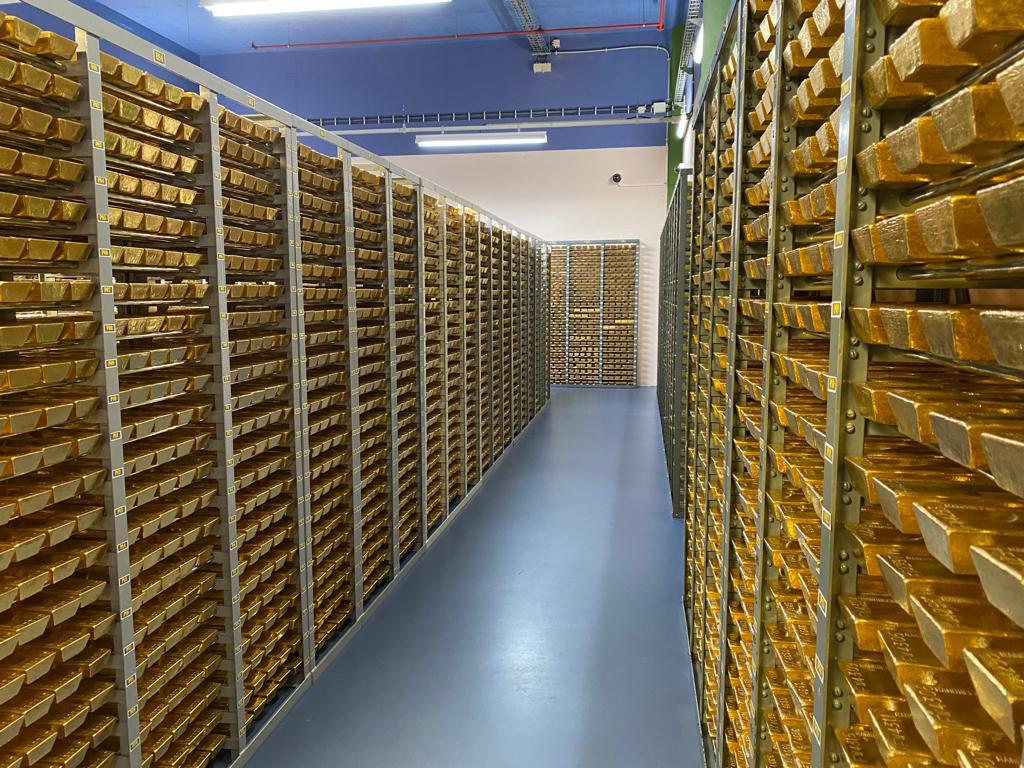
Gold Hits Record $3,745 as Policy Uncertainty Fuels Precious Metal Surge
Gold Hits Record $3,745 as Policy Uncertainty Fuels Precious Metal Surge
Central Banks and Policy Turmoil Drive Bullion to New Heights as Traditional Investment Logic Transforms
Gold prices shattered records on Monday, reaching $3,745 per ounce in what market veterans are calling one of the most significant precious metal rallies in decades. The surge represents a stunning doubling in value since the end of 2022, fundamentally reshaping how institutional investors view the traditional safe-haven asset.
Gold Price Per Ounce (USD) Over Time, showing the dramatic surge to a record high.
| Date | Gold Price (USD/ounce) |
|---|---|
| January 31, 2022 | $1,796.47 |
| January 31, 2023 | $1,927.88 |
| January 31, 2024 | $2,037.19 |
| September 22, 2025 | $3,745.52 |
The unprecedented climb reflects a convergence of forces that extend far beyond typical market dynamics. Central bank gold purchases have reached their highest levels since the early 1970s, while mounting concerns about Federal Reserve independence and escalating trade tensions create what analysts describe as a "perfect storm" for precious metal demand.

The New Arithmetic of Safe Haven Investing
The mathematics driving gold's ascent center on what market professionals call the "real rate collapse." The Federal Reserve's September quarter-point rate cut, combined with market expectations of additional easing, has mechanically reduced the opportunity cost of holding zero-yield assets like gold.
Real yields measure the true return on an investment after accounting for inflation. When these yields are low or negative, gold becomes a more attractive store of value because the opportunity cost of holding the non-yielding precious metal decreases, as traditional interest-bearing assets offer poor real returns.
"We're witnessing a policy-driven transformation in how institutions calculate risk-adjusted returns," explained one senior portfolio manager at a major pension fund. "When real yields fall while policy uncertainty rises, gold becomes not just defensive but strategically essential."
This shift becomes more pronounced when examining the composition of demand. Central banks have purchased over 1,000 tonnes annually since 2022—roughly 23% of total demand—representing a fundamental reallocation rather than speculative positioning. The purchases reflect what industry insiders characterize as a post-sanctions "reserve safety" response, particularly among emerging market central banks seeking alternatives to dollar-denominated assets.
ETF Renaissance Amplifies Institutional Flows
Exchange-traded fund flows have experienced a dramatic reversal, transitioning from significant headwinds in 2022-2023 to becoming powerful tailwinds throughout 2025. The year has witnessed the strongest first-half inflows since 2020, with holdings climbing back to their highest levels since 2022.
Global Gold ETF Inflows and Outflows by year, highlighting the reversal from outflows to strong inflows.
| Year | Global Gold ETF Net Flows (USD Billions) | Global Gold ETF Net Flows (Tonnes) |
|---|---|---|
| 2025 (YTD) | +$57.1 | +203.28 (as of Sep 19) |
| 2024 | Inflows (first in 4 years) | Holdings fell slightly (-0.2%) |
| 2023 | Outflows | Outflows |
| 2022 | Outflows | Outflows |
| 2021 | Outflows | Outflows |
| 2020 | Strong inflows (GLD: +$15.1) | - |
This ETF resurgence creates what traders describe as "reflexive amplification"—rising prices attract institutional flows, which drive prices higher still. The dynamic particularly benefits systematic and macro funds operating on rate-cut expectations, while providing the liquidity infrastructure that central bank purchases alone cannot generate.
Market structure analysis reveals that unlike previous gold rallies driven primarily by retail mania or crisis sentiment, the current surge maintains an unusually "official-heavy" composition. This institutional foundation suggests greater resilience against sentiment-driven reversals that historically ended precious metal bull markets.
Trump Administration Policy Mix Creates Tailwinds
The current administration's policy framework presents what analysts term a "classically gold-positive" environment. The implementation of a 10% baseline tariff, supplemented by reciprocal surcharges on specific trading partners, introduces inflationary pressures while simultaneously generating growth uncertainty—a combination that historically benefits defensive assets.
Beyond trade policy, rapidly shifting security postures maintain elevated tail-risk premiums. The administration's reversal of previous Western security policies, including arming Ukraine while pressuring buyers of Russian exports, keeps geopolitical uncertainty at elevated levels that favor precious metal holdings.
Perhaps most significantly, mounting concerns about Federal Reserve independence have introduced what some strategists describe as a persistent "policy credibility premium" in gold pricing. Highly public pressure on Fed officials and unusual dovish dissenting opinions have created market conditions where gold functions as a hedge against institutional erosion rather than merely economic uncertainty.
Physical Demand Patterns Signal Structural Shift
Traditional physical demand patterns reveal the maturation of gold's current bull market. Jewelry fabrication has declined 14% year-over-year in the second quarter, with projections suggesting a 16% full-year decline for 2025. This price-driven rationing in consumer markets represents typical behavior during secular precious metal advances, where investment demand crowds out ornamental usage.
Breakdown of Global Gold Demand by Sector, showing the changing shares of investment, central banks, jewelry, and technology.
| Period | Investment (t) | Central Banks (t) | Jewelry (t) | Technology (t) | Total Demand (t) |
|---|---|---|---|---|---|
| Full Year 2024 | 1,180 | 1,000+ | 1,877 | 326 | 4,974 |
| Q1 2025 | 552 | 244 | 425.41 | 80 | 1,206 |
| Q2 2025 | 477.20 | 166.46 | 356.70 | 78.60 | 1,249 |
Global gold demand in 2024 reached a record 4,974 tonnes, driven significantly by central bank purchases that exceeded 1,000 tonnes for the third consecutive year, and a 25% year-on-year increase in investment demand to 1,180 tonnes. Jewellery demand, however, saw an 11% decline to 1,877 tonnes due to rising gold prices. The technology sector experienced a 7% increase in demand, reaching 326 tonnes, attributed to growth in AI applications.
In the first quarter of 2025, total gold demand, including over-the-counter (OTC) investment, was 1,206 tonnes, marking the highest Q1 since 2016. Investment demand more than doubled to 552 tonnes, fueled by a sharp revival in gold ETF inflows. Central banks continued their significant buying, adding 244 tonnes to global holdings. Technology demand remained steady at 80 tonnes, supported by ongoing AI adoption. Jewellery demand volumes fell sharply in response to record gold prices, reaching their lowest since 2020, at approximately 425.41 tonnes.
The second quarter of 2025 saw total gold demand rise by 3% year-on-year to 1,249 tonnes. Investment demand stood at 477.20 tonnes, while central banks added 166.46 tonnes. Jewellery demand was 356.70 tonnes, and technology demand was 78.60 tonnes.
The softening in Chinese and Indian jewelry markets, traditionally viewed as critical demand pillars, appears less concerning to institutional analysts when contextualized within broader structural shifts. Central bank purchases provide a floor that enables jewelry demand destruction without threatening the overall bullish thesis.
Mining sector dynamics further support the sustainability narrative. Companies are experiencing windfall margins that facilitate easier equity and debt financing, while initial public offering and merger activity accelerates. However, industry observers caution that cost inflation in energy and wages, combined with permitting constraints and potential political risks from royalty increases, could challenge operational execution.
Forward-Looking Investment Framework
Market positioning suggests three distinct scenarios for the three-to-six-month horizon. The base case anticipates a high plateau with choppy upward bias, targeting a $3,600-$3,950 range. This scenario assumes continued Federal Reserve easing, persistent tariff regimes, and episodic ETF inflows alongside sustained central bank accumulation.
The bull case envisions a momentum-driven breakout toward the psychologically significant $4,000 level, potentially triggered by additional policy noise around Federal Reserve independence or tariff escalation. Street commentary increasingly gravitates toward this round-number target as reflexive ETF dynamics gain momentum.
Market reflexivity, a concept famously associated with George Soros, describes a two-way feedback loop where participants' perceptions influence market fundamentals, and these altered fundamentals then further influence perceptions. This creates a positive feedback cycle in financial markets, where beliefs and reality mutually reinforce each other.
Conversely, the bear case projects a correction to $3,200-$3,450, driven by upside inflation surprises that force a hawkish Federal Reserve pivot. Such a scenario would likely stall ETF inflows while testing the price sensitivity of official-sector demand at record levels.
Investment professionals emphasize maintaining unlevered core positions while expressing tactical views through options strategies. The structural nature of central bank demand suggests staying invested through volatility, while using call spreads to capture upside convexity during event clusters.
Risk Management in Uncharted Territory
The unprecedented nature of gold's current level creates unique risk management challenges. Traditional technical analysis becomes less reliable when price discovery occurs in uncharted territory, while the composition of demand reduces historical parallel effectiveness.
Practitioners emphasize monitoring key indicators including World Gold Council monthly ETF flow data, central bank reserve disclosures from major accumulating nations, and real yield movements in five-year, five-year forward rates. The interplay between these factors may provide early warning signals for directional changes.
Cross-market implications suggest gold's strength reflects non-trivial odds assigned to both lower real rates and higher policy uncertainty. For fixed income investors, sustained precious metal strength provides friendly confirmation of duration positioning, while currency markets must contend with term-premium-led dollar risks rather than cyclical collapse scenarios.
As traditional portfolio theory adapts to an environment where policy uncertainty rivals economic fundamentals as a primary market driver, gold's evolution from tactical hedge to strategic allocation appears increasingly permanent. The convergence of structural demand from central banks, reflexive investment flows, and policy mix uncertainty creates conditions that may sustain elevated precious metal prices well beyond current market expectations.
House Investment Thesis
| Category | Summary Details |
|---|---|
| Overall Thesis | Gold's rally is a legitimate "regime trade" driven by structural factors, not speculation. Base case is a high, choppy plateau ($3,600-$3,950) into year-end with reflexive upside tails. |
| Primary Drivers | 1. Real-rate path (Cyclical): Primary driver. Easing Fed policy (cuts) lowers opportunity cost. A hawkish pivot/rising real yields are the key risk. 2. Official-sector allocation (Structural): Central banks buying >1,000t annually provides a durable floor, compressing drawdowns. 3. ETF flows (Reflexive): Shift from outflows to strong inflows amplifies price moves; flows follow price, then drive it. 4. Policy mix: Tariffs (inflationary/growth uncertainty) and noise around Fed independence create a hedge bid. 5. Physical demand: High prices ration jewelry demand, which is normal in a secular bull market; investment demand takes over. |
| Author's Views (Mispricings) | • ETF fragility is overstated: Official buying is the foundation; ETFs are a momentum layer. • Policy uncertainty is sticky: Tariffs and Fed-political risk support a permanently higher gold price. • Fed-independence premium is real: Creates a persistent option value for gold. |
| Near-Term Path (3-6 Months) | • Base Case: $3,600 - $3,950. Shallow pullbacks unless real yields lurch higher. • Bull Case (>$4k): Policy escalation (tariffs/Fed) + softer growth + ETF reflexivity. • Bear Case ($3,200-$3,450): Hawkish Fed pushback (sticky CPI) stalls ETF bids and tests official-sector price sensitivity. |
| Positioning & Trade Ideas | • Core: Unlevered physical/low-fee ETFs to capture structural bid. • Tactical: Call spreads, calendar diagonals, long gold/short tariff-sensitive EM FX, miners (low-cost, low-risk), arbitrage (COMEX-Shanghai). |
| Risks & Accelerants | • Upside: Policy shock (tariffs/Fed), ETF "melt-up" reflexivity. • Downside: Real-rate snapback (hawkish Fed), official-buying pause, positioning washout from stretched longs. |
| Cross-Market Signals | • Rates: Gold strength confirms lower real rates/policy uncertainty. • FX: Suggests term-premium-led USD risks, not cyclical collapse. • Credit/Equities: Gold rally with tight spreads signals a "policy-mix hedge," not recession fear. |
| Monitoring Dashboard | 1. WGC monthly ETF flows. 2. Central bank reserve disclosures. 3. Tariff tracker headlines. 4. Fed-independence "temperature." 5. Physical demand in China/India. |
| One-Line Playbook | Strategic: Long gold as a policy-regime hedge. Tactical: Buy dips from data-driven rate wiggles. Risk Control: Use spreads for upside; avoid naked shorting due to asymmetric left tails. |
NOT INVESTMENT ADVICE